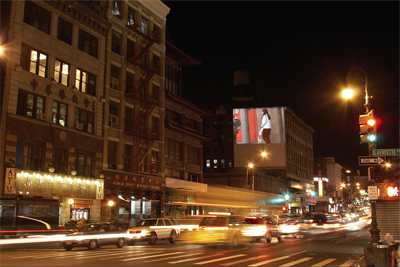

Solange Fabião -------------------------------------------- in Chinatown New York-based Brazilian artist Solange Fabião is in the midst of an ambitious and migratory public art series she calls "Transitio." The first large-scale installment in an outdoor space took place in Beirut in 2004. It involved the projection of a video onto the side of the Beirut city Center building, a famous, egg-shaped former cinema damaged by war and neglect. The motion-filled video, titled Duration: One Hour and 3 Minutes-Location: 17.3 Miles, is of street scenes along the entire length of Broadway in New York City, which Fabião took while riding in a taxi in 2001. New York in Beirut, and by extension America in the Middle East, is fraught with connotations, but what's most impressive is how a building in one city temporarily displays another city, resulting in a fascinating blend of architecture, cultures, histories and urban identities. In Beirut, the New York video alternated with another of Shanghai, again taken from a car. Fabião has since similarly recorded several other far-flung urban centers, and she is planning on realizing versions of "Transitio" in 10 cities throughout the world.Transitio_NYC, the second installment, featured an interesting twist. For 12 nights in October 2005, a large, 40-minute video loop of two Chinese cities, Nanning (in Guangxu) and Shanghai, was projected onto the side of a building on Canal Street in New York's Chinatown, The art crowd was there and was duly enthralled, but it was also fascinating to note the surprised reaction of neighborhood residents, looking up to see the homeland many had left. The non-narrative video shifts between a rainy day in Nanning and a clear one in Shanghai. Fabião's own movements in the car, her occasional use of slow and fast motion in the video and quick transitions between details make for a dizzying whirl of images, which double as a voyage of discovery. One sees street-side vendors, staircases, office buildings, gritty apartments, signage traffic and an eclectic assortment of people from different social strata. Oftentimes, mundane things--someone's momentary expression, or a shadow jutting across a building's façade--are a completely captivating, but because everything is in such rapid flux, one gets mostly fleeting impressions. The video does not focus on the gleaming skyscrapers and massive developments of the new China, but instead on a daily, tenacious, unremarkable China that still seems inviting, and packed with diverse information.Curated by New York critic Carolee Thea, and funded and assisted by several organizations and private donors, Fabião's outdoor projection had a spectacular quality, akin to large-than-life billboards or movies on the big screen. Still, its origins are humble: just one woman's darting, ever-curious view as she drives through unfamiliar places. While transported to distant Chinese metropolises, one also paid heightened attention to this particular corner of New York, with its own mixed architecture, snarled traffic and vibrant street life. In an internationally fractious time, Fabião's linked cities were both welcome and apt.- Gregory Volk |
||||
| View of Solange Fabião’s video projection Transitio_NYC, Oct. 20-31, 2005; at the corner of Canal and Center Streets |
||||
 |
||||